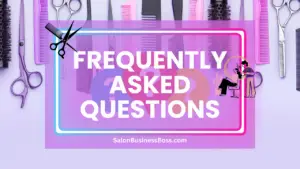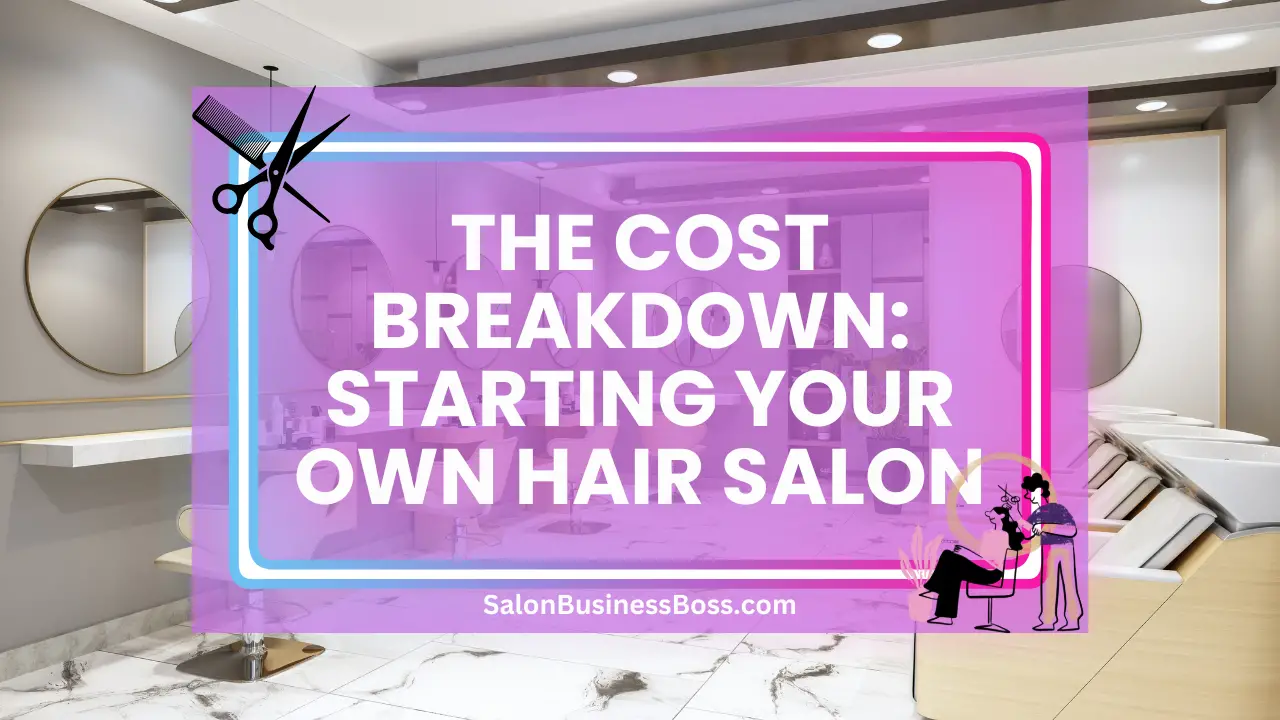Starting a hair salon can be a rewarding venture, offering you the opportunity to showcase your creativity and passion for hairstyling. However, like any business endeavor, opening a hair salon comes with a cost.
Average cost of starting a hair salon starts at $90,000. This includes leasing a commercial space, buying furnishings & equipment, stocking inventory, obtaining licenses, marketing, and insurance. Proper budgeting and planning are vital for a positive salon launch.
1. Location and Lease Costs:
The location of a hair salon is a crucial factor that can make or break its success. Choosing the right location plays a pivotal role in attracting a steady flow of customers and establishing a strong presence in the market. Ideally, a hair salon should be situated in a high-traffic area with good visibility to capture the attention of passersby and potential clients. Such locations are often found in popular commercial districts or busy shopping centers.
The benefits of a prime location come with a price. Commercial spaces in areas with high foot traffic tend to have higher lease costs compared to less prominent locations. On average, leasing a commercial space for a hair salon can range from $1,500 to $5,000 per month, depending on the region and the size of the space. The larger the space and the more sought-after the area, the higher the lease cost will be.
Landlords commonly require a security deposit before granting access to the space. This deposit can amount to up to three months’ worth of rent, further adding to the initial expenses associated with starting the hair salon.
Choosing the right location involves a careful balance between affordability and visibility. While a prime location can provide a head start in attracting customers, it’s crucial to conduct thorough market research and assess the potential return on investment before committing to a particular spot. Ultimately, a well-chosen location can give a hair salon a competitive edge and set the stage for long-term success.
2. Salon Furnishings and Equipment:
Designing a welcoming and stylish ambiance is a fundamental aspect of attracting and retaining customers in a hair salon. The overall atmosphere sets the tone for the client’s experience and can greatly influence their decision to return. To achieve this, investing in high-quality salon furnishings and equipment is essential.
Salon furnishings encompass a range of items, including comfortable chairs for clients and stylists, functional styling stations for hairstyling and product displays, shampoo bowls for hair washing, hair dryers, well-positioned mirrors for clients to view their hair transformations, and an organized reception desk to handle appointments and inquiries seamlessly. Each element contributes to the overall experience and impression of the salon.
The pursuit of a top-notch ambiance comes at a cost. High-quality salon equipment can be expensive, with average costs varying from $15,000 to $30,000, depending on the salon’s size and the level of sophistication desired. Larger salons or those aiming for a luxurious and upscale experience may lean towards the higher end of this cost range.
Investing in top-notch furnishings and equipment pays dividends in the long run. Not only does it enhance the client’s experience and satisfaction, but it also creates a positive reputation for the salon. Clients are more likely to recommend a salon with a welcoming atmosphere, leading to increased word-of-mouth referrals and customer loyalty.
To strike a balance between cost and quality, salon owners should carefully research suppliers and equipment options. Consideration should also be given to the long-term durability and maintenance costs of the chosen furnishings. By making well-informed decisions, salon owners can create a delightful ambiance that resonates with clients, elevating the salon’s brand and setting the stage for a thriving business.
3. Salon Supplies and Inventory:

Aside from investing in salon furnishings and equipment, another critical aspect of setting up a successful hair salon is building a well-stocked inventory of hair care products, styling tools, and beauty supplies. Creating a diverse and appealing range of products is essential to meet the varying needs and preferences of your clientele.
The inventory for a hair salon typically includes an assortment of high-quality shampoos, conditioners, hair dyes, styling gels, hairbrushes, hair sprays, serums, and other specialized hair treatments. Depending on the size of your salon and the scope of services you aim to provide, the initial cost of stocking the inventory can range from $5,000 to $10,000 or more.
Salon owners should consider the demographics and preferences of their target customers when selecting products for their inventory. Offering reputable and trusted brands helps build customer confidence in the salon’s offerings. Additionally, catering to diverse hair types and styling needs ensures a broader client base and encourages repeat business.
Careful inventory management is vital to prevent overstocking or understocking, as both scenarios can negatively impact the salon’s finances. Regularly monitoring product usage and popularity can help maintain an optimal inventory level and minimize waste.
As the salon gains popularity and customer feedback accumulates, adjusting the inventory to meet evolving demands becomes crucial. Expanding the product range or introducing new lines can invigorate the salon’s offerings and demonstrate the salon’s commitment to staying updated with the latest trends and innovations.
By investing wisely in a diverse and carefully curated inventory, salon owners can enhance the overall customer experience, foster client loyalty, and contribute to the salon’s long-term success.
Read more about: Setting Up a Hair Salon: Practices and Strategies
4. Licensing and Permits:
Complying with legal regulations is a critical step before launching your hair salon. Obtaining the necessary licenses and permits is essential to operate legally and avoid potential fines or closures. The specific licenses and permits required may vary based on your location and the services you plan to offer.
Common licenses for a hair salon include a general business license and a health permit to ensure your salon meets hygiene and safety standards. Additionally, many states and localities have specific regulations for salon establishments, necessitating salon-specific permits.
The cost of obtaining these licenses and permits can vary depending on your location and the complexity of the application process. On average, budgeting around $1,000 to $3,000 is recommended to cover the expenses associated with obtaining the required documentation.
Before proceeding with the application process, conduct thorough research or seek advice from local authorities or legal professionals to ensure you understand the specific requirements for your area. Some jurisdictions may require additional certifications, such as cosmetology licenses for salon staff, which could add to the overall cost.
It’s crucial to allocate sufficient funds for licenses and permits in your initial budget to avoid unexpected financial strain. Failing to obtain the necessary permits can lead to severe consequences, including fines and potential closure of your salon.
By proactively securing the appropriate licenses and permits, you demonstrate your commitment to ethical business practices and ensure a smooth and legally compliant launch for your hair salon.
5. Marketing and Advertising:
Effective marketing and advertising play a pivotal role in establishing brand awareness and attracting a steady stream of customers to your hair salon, especially in its initial phase. A well-thought-out marketing strategy can make all the difference in creating a lasting impression on potential clients.
To start, creating a professional website is crucial for establishing your online presence. This platform allows you to showcase your salon’s services, staff, and ambiance, making it easier for potential clients to find and contact you. Additionally, investing in a professionally designed logo and business cards helps reinforce your salon’s brand identity and professionalism.
In today’s digital age, social media platforms are powerful tools for engaging with potential customers and building a loyal client base. Setting up and maintaining active social media accounts on platforms like Facebook, Instagram, and Twitter can help you reach a broader audience and showcase your salon’s expertise through compelling visual content.
Marketing costs can vary depending on the extent of your strategy and the platforms you choose to advertise on. Budgeting between $2,000 to $5,000 or more is advisable for initial marketing expenses. Keep in mind that marketing efforts should be ongoing to maintain momentum and continue attracting new customers throughout your salon’s lifecycle.
6. Salon Software and POS System:
Investing in salon management software and a Point of Sale (POS) system can significantly enhance the efficiency and organization of your hair salon operations. A comprehensive salon software system can streamline appointment booking, track inventory, manage customer information, and facilitate sales transactions.
The cost of salon software can vary based on the features and capabilities offered by different providers. On average, salon owners can expect to spend between $100 to $300 per month for a reliable and robust salon software system.
A salon management software helps you schedule appointments, manage staff availability, and send automated reminders to clients, reducing the likelihood of missed appointments and improving customer satisfaction. Additionally, tracking inventory levels through the software ensures that you have a clear understanding of product availability and can promptly restock when needed.
A Point of Sale system simplifies payment processing, making transactions seamless for both clients and staff. With the ability to accept various payment methods, including credit cards and digital wallets, the POS system offers convenience to your customers while streamlining your financial management.
Investing in salon software and a POS system is a smart move that can enhance the customer experience, optimize operational efficiency, and ultimately contribute to the growth and success of your hair salon.
7. Staff Salaries and Training:

Building a skilled and motivated team is vital for the success of your hair salon. Allocating a portion of your budget for staff salaries is essential to attract and retain talented stylists and support personnel. The initial salaries you offer will depend on factors such as experience levels, location, and the responsibilities of each position. Experienced stylists may demand higher compensation, while entry-level employees may be willing to accept lower starting wages.
Investing in staff training is crucial to keep your team updated with the latest trends, techniques, and industry standards. Continuous training helps enhance the skillset of your staff, elevating the quality of service your salon provides. Depending on the training programs and workshops you choose, annual training costs per stylist can range from $1,000 to $5,000.
By providing competitive salaries and opportunities for professional growth, you create a positive work environment that fosters employee satisfaction and loyalty. Happy and well-trained staff are more likely to provide exceptional service to your clients, leading to customer retention and positive word-of-mouth referrals.
Read more about: Know Before You Go: Understanding Salon Set Up Cost
8. Insurance Coverage:
Securing comprehensive insurance coverage for your hair salon is a fundamental aspect of risk management. It protects your business from potential liabilities, accidents, and unforeseen events. Insurance costs can vary depending on factors such as the salon’s size, location, and the specific coverage options you choose.
A standard insurance policy for a hair salon typically includes general liability insurance, property insurance, and professional liability insurance (also known as malpractice or errors and omissions insurance). The average cost of a comprehensive insurance policy can range from $500 to $1,500 per year, depending on the level of coverage and the insurance provider.
Investing in insurance is a proactive measure that provides peace of mind and financial protection in case of accidents, property damage, or legal claims. It demonstrates a commitment to responsible business practices and safeguards your salon’s assets and reputation.
9. Utilities and Miscellaneous Expenses:
Budgeting for utilities is a crucial component of your salon’s operational costs. Monthly utility expenses, such as electricity, water, and heating/cooling, should be factored into your budget. The actual cost will depend on your location, the size of your salon, and energy consumption.
Apart from utilities, it’s wise to allocate a portion of your budget for miscellaneous expenses and unforeseen contingencies. Running a business often comes with unexpected costs, such as equipment repairs, maintenance, or unexpected supply needs. By creating a contingency fund for miscellaneous expenses, you can handle such situations without disrupting your salon’s operations or financial stability.
Prudent financial planning and budgeting for utilities and miscellaneous expenses contribute to the long-term sustainability of your hair salon. Being prepared for the unexpected ensures your salon can continue providing quality services to clients while navigating any unforeseen challenges that may arise.
Conclusion
Starting a hair salon is undoubtedly a significant financial undertaking, with the average cost ranging from $90,000 to $150,000 or more, depending on various factors. Careful planning, budgeting, and market research are essential to ensure the success of your salon. Remember that cutting corners in the initial stages may lead to compromises on the quality of your salon, so it’s crucial to strike a balance between costs and the overall experience you wish to offer to your customers. By understanding and preparing for these expenses, you’ll be better equipped to turn your hair salon dream into a thriving reality.
Frequently Asked Questions

1. Are staff salaries included in the startup cost?
Staff salaries and training costs are separate and should be budgeted accordingly. Plan for employee salaries based on their experience levels.
2. How much does insurance coverage cost for a hair salon?
Insurance costs typically range from $500 to $1,500 per year, depending on the coverage options you choose.
3. Can I start a hair salon on a tighter budget?
While possible, cutting corners may impact the quality of your salon. It’s essential to find a balance between costs and the salon’s overall experience.
To learn more on how to start you own salon checkout my startup documents here.
Please note that the contents of this blog are for informational and entertainment purposes only and should not be construed as legal advice. Any action taken based on the information provided in this blog is solely at your own risk. Additionally, all images used in this blog are generated under the CC0 license of Creative Commons, which means they are free to use for any purpose without attribution.

About the author. Entrepreneur and Salon Business Fan.
Hi! I am Shawn and I am a happy individual who happens to be an entrepreneur. I have owned several types of businesses in my life from a coffee shop to an import and export business to an online review business plus a few more and now I create online salon business resources for those interested in starting new ventures. It’s demanding work but I love it. I do it for those passionate about their business and their goals. That’s why when I meet a salon business owner, I see myself. I know how hard the struggle is to retain clients, find good employees and keep the business growing all while trying to stay competitive.
That’s why I created Salon Business Boss: I want to help salon business owners like you build a thriving business that brings you endless joy and supports your ideal lifestyle.

